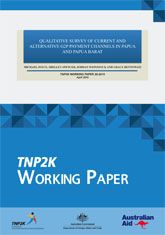Qualitative Survey of Current and Alternative G2P Payment Channels in Papua and Papua Barat
Working Paper 26
April 2015
Author: Michael Joyce, Shelley Spencer, Jordan Weinstock and Grace Retnowati
Many Papuans are eligible for social assistance in the form of government-to-person (G2P) payments because the poverty levels in Papua and Papua Barat are among the highest in the country. However, disbursing these payments is difficult, costly and time-consuming. Recent developments in technology and regulatory environments in Indonesia mean that G2P payments could potentially be delivered using locally-based agents and low-cost payment instruments such as electronic money or branchless banking. This research provides a snapshot of current payment practices in 18 subdistricts in Papua and Papua Barat that have varying degrees of accessibility. It reveals that beneficiaries are interested in and willing to try alternative payment mechanisms. The research focuses on payments made from the Conditional Cash Transfer Programme for Poor Families (PKH) and the Cash Transfers for Poor Students programme (BSM) but also looked at other payment streams, including salaries for the civil servants and teachers living in the subdistricts studied.
The research shows that the costs of travelling to reach current payment points and the time this takes are major challenges for beneficiaries of these programmes and this situation could be alleviated if alternative payments channels were possible. The research presents a cost–benefit model that suggests potential pricing models for different payment locations. However, before these alternative payment channels can be introduced, Papua and Papua Barat need to have reliable power, transport and communications infrastructures throughout the subdistricts and this remains a major obstacle. Until this issue can be tackled, some areas will need to continue using existing payment methods for the foreseeable future.
The TNP2K Working Paper Series disseminates the findings of work in progress to encourage discussion and exchange of ideas on poverty, social protection and development issues.
Support for this publication has been provided by the Australian Government through the Poverty Reduction Support Facility (PRSF).
The findings, interpretations and conclusions herein are those of the author(s) and do not necessarily reflect the views of the Government of Indonesia or the Government of Australia.
You are free to copy, distribute and transmit this work, for non-commercial purposes.
Suggested citation: Joyce, M., S. Spencer, J. Weinstock and G. Retnowati. 2015. ‘Qualitative Survey of Current and Alternative G2P Payment Channels in Papua and Papua Barat’. TNP2K Working Paper 26-2015. Jakarta, Indonesia: National Team for the Acceleration of Poverty Reduction (TNP2K).
To request copies of this paper or for more information, please contact the TNP2K - Knowledge Management Unit (kmu@tnp2k.go.id). This and other TNP2K publications are also available at the TNP2K website.
